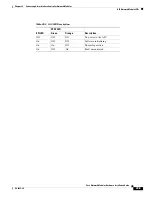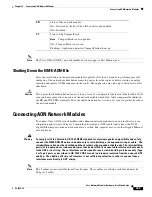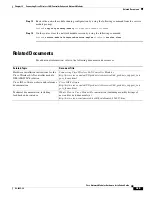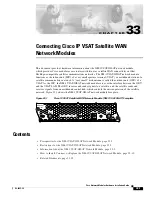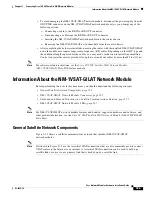
31-3
Cisco Network Modules Hardware Installation Guide
OL-2485-20
Chapter 31 Connecting Cisco Wireless LAN Controller Modules
Online Insertion and Removal with a Cisco Wireless LAN Controller Module
Online Insertion and Removal with a Cisco Wireless LAN
Controller Module
The Cisco integrated services routers (ISRs) allow you to replace network modules without switching
off the router or affecting the operation of other interfaces. This feature is called online insertion and
removal (OIR). OIR of network modules provides uninterrupted operation to network users, maintains
routing information, and ensures session preservation.
Note
OIR of the controller module is supported only on the Cisco 3745 router and the Cisco 3845 ISR.
Tip
For information about module slot locations and numbering on Cisco routers, see
“Network Module Slot
Locations and Numbering on Cisco Access Routers” section on page 1-3
.
For a description of informational and error messages that may appear on the console during this
procedure, see the hardware installation guide for your type of router.
Saving the Configuration File
This configuration assumes a configuration file already exists on the Cisco WLAN controller module
CompactFlash memory card. To save the configuration file, follow these steps with the router in
privileged EXEC mode.
Step 1
Initiate a WLAN controller module console access session using the following command:
Router#
service-module wlan-controller
1
/
0
session
Trying 192.0.2.254, 2066 ... Open
Step 2
Set the TFTP server IP address from the WLAN controller module console access session:
(WLAN-Controller) >
transfer upload
serverip
192.0.2.24
Step 3
Set the datatype configuration using the following command:
(WLAN-Controller) >
transfer upload
datatype
configuration
Step 4
Set the running configuration file using the following command:
(WLAN-Controller) >
transfer upload filename
<
config-running.bin
>
Step 5
Start the TFTP transfer using the following command from the WLAN-Controller prompt:
(WLAN-Controller) >
transfer upload start
Mode............................................. TFTP
TFTP Server IP................................... 192.0.2.24
TFTP Path........................................ /
TFTP Filename.................................... config.bin
Data Type........................................ Config File
Encryption....................................... Disabled
**************************************************
*** WARNING: Config File Encryption Disabled ***
**************************************************



